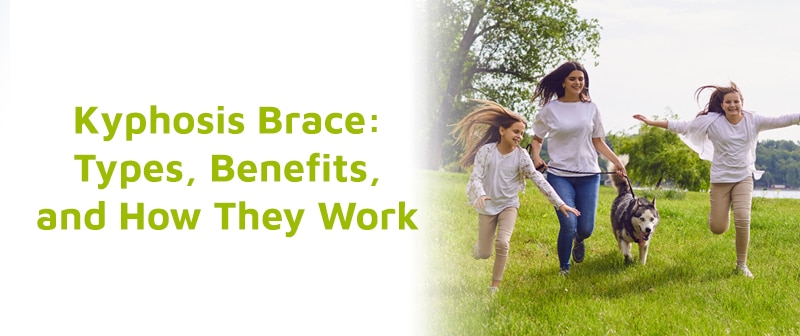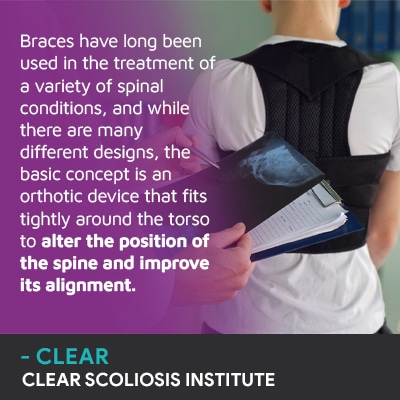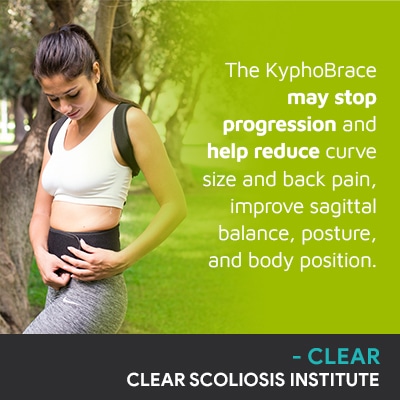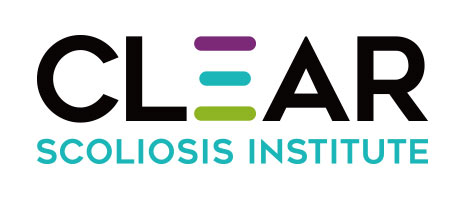
There are different types of braces for addressing spinal conditions; some focus on stopping a condition from progressing, while others focus on corrective results. Correcting an unhealthy spinal curve involves an individualized treatment plan; continue reading to learn more about the corrective potential of kyphosis treatment and the KyphoBrace™.
Kyphosis is a spinal condition that causes the middle/upper back to round forward excessively. A corrective KyphoBrace™ can help relieve pain, improve posture, and restore a healthy degree of kyphosis to the thoracic spine.
Spines are curved for a number of reasons, two of which are strength and flexibility, but when a spinal curve becomes excessive, problems can occur.
A healthy spine sits in a straight and neutral position and will have its healthy curves in place.
The spine is one long complex structure with three main sections: the cervical spine, thoracic spine, and the lumbar spine.
Each spinal section (the neck, middle/upper back, lower back) has a curvature type, and while these curve sizes can vary person to person, if they don't fall within a typical healthy range, they can disrupt the biomechanics of the entire spine.
Kyphosis refers to the outward-bending spinal curve in the thoracic spine, and a healthy range of thoracic kyphosis is considered to be between 20 and 40 degrees, with hyperkyphosis commonly diagnosed at 40+ degrees when measured between T4 and T12 (4th to the 12th vertebrae of the thoracic spine).
Lordosis is the opposite spinal curvature type that bends inwards at the cervical and lumbar spinal sections in a 'C' shape.
If a person's level of kyphosis is excessive, the spine will bend away from the body's center, in a reverse 'C' shape, excessively, and the main effect of this is a noticeably rounded forward upper back and shoulders; kyphosis, aka hyperkyphosis, is also commonly referred to as roundback because of how it affects posture.

Treating kyphosis involves first determining its type and underlying cause, and once this is determined, along with condition severity and experienced symptoms, a treatment plan can be customized.
Braces have long been used in the treatment of a variety of spinal conditions, and while there are many different designs, the basic concept is an orthotic device that fits tightly around the torso to alter the position of the spine and improve its alignment.
There are different types of braces with different brace-wearing prescriptions; some will involve full-time wear, and some braces are prescribed for part time wear. Braces have to be worn exactly as prescribed in order for brace treatment to be effective, making compliance a key factor.
Kyphosis is commonly diagnosed during adolescence, and particularly for adolescents, compliance can be an issue. Most adolescents and teenagers want to fit in with their peers; they don't want to look different, walk differently, or have to wear a brace at school all day, and not all braces are comfortable, easy to move in, and easy to conceal under clothes.
While some braces are designed around the goal of stopping an unnatural spinal curve from getting worse, others have correction as their end goal, and some can facilitate both; this is the case with the ultra-corrective KyphoBrace™.
A KyphoBrace™ is a 3-dimensional custom designed corrective brace, and the goal of the KyphoBrace™ is to stop progression and restore a patient's posture and healthy degree of kyphosis.
As a patient's posture is improved and additional facets of treatment are applied, the KyphoBrace™ can help improve the spine's position, alignment, stability, and balance.
The KyphoBrace™ uses computer aided design software (CAD), multiple scans, digital X-rays, and postural photos to ensure that each brace addresses the specifics of a patient's body and curvature type, making them more comfortable to wear, and addressing one of the main challenges of bracing: compliance.
The KyphoBrace™ may stop progression and help reduce curve size and back pain, improve sagittal balance, posture, and body position.
As growing spines are more flexible, the KyphoBrace™ is commonly used in the treatment of hyperkyphosis in children and adolescents who have not yet reached skeletal maturity, and show the most success at correcting kyphotic curves measuring between 55 and 80 degrees.
Used in the treatment of hyperkyphosis, Scheuermann's kyphosis, thoracolumbar kyphosis, and anterior sagittal balance, the KyphoBrace™ is part of a non-surgical treatment approach that combines the power of multiple therapies and facets of treatment for the best potential results.
The most common type of kyphosis is nonstructural: postural kyphosis. Postural kyphosis is caused by chronic poor posture but is the simplest type to treat because a change in posture and body position can alter the curve.
Bracing is most commonly used when treating structural spinal conditions such as Scheuermann's kyphosis because when a condition is structural, the spine is going to be more rigid and difficult to alter.
Scheuermann's kyphosis can often benefit from brace treatment because as a structural condition, there is a structural abnormality within the spine itself.
In some cases of Scheuermann's disease, the spine's vertebrae can be more triangular in shape, making it difficult for the spine to stay aligned and maintain its healthy curves and normal position, instead causing them to wedge and curve forward unnaturally.
Mild kyphosis might not produce noticeable symptoms, but curve progression is likely in severe cases, and pain relief can be a necessary focus of treatment.

As patients age, the spine can become increasingly unstable due to natural age-related spinal degeneration, and when a spinal condition like hyperkyphosis is present, this can increase a patient's level and rate of degenerative changes.
A diagnosis of hyper kyphosis can also affect the cervical spine as an excessive middle/upper back kyphotic curve also introduces uneven forces to the neck above, so shoulder and neck pain can be common.
The spine can also respond to the development of an unhealthy spinal curve by adding a compensatory curve elsewhere in the spine; this is an attempt to counteract the first unnatural curve's uneven forces.
As one long structure, the health of each spinal section is dependent upon the health of the others.
Difficulty sitting and/or standing for long periods of time can also be a challenge, and a person's gait can be affected as it becomes increasingly difficult to maintain an economical gait; the excessive rounded forward spinal curve causes the trunk's weight to be unevenly distributed over the pelvis and lower body.
Pain as a symptom can include muscle pain, back pain, and radiating pain caused by nerve compression, and typically, the longer kyphosis is left untreated, the more serious it's going to become and the more noticeable its symptoms are likely to become over time.
The spine's natural curves shape its strength and function, and when the spine's level of kyphosis becomes excessive and problematic, this is diagnosed as kyphosis and/or hyperkyphosis.
There are different types of kyphosis including postural kyphosis, Scheuermann's kyphosis, and congenital kyphosis that babies are born with due to the spine not forming properly.
Treatment for kyphosis can involve a kyphosis brace with corrective potential like the KyphoBrace™ that is highly specialized and has shown impressive results, particularly in the treatment of hyperkyphosis in adolescents.
Common symptoms of hyperkyphosis can include postural changes that include a rounded-forward posture, a prominent stoop that's likely to become more pronounced throughout the day, disruptions to balance, gait, and back, muscle, and/or nerve pain.
When the spine is curved unnaturally, it also affects the spine's surrounding muscles and nerves, and if the unhealthy curve is introducing uneven pressure to a spinal nerve, radiating pain and sensory issues can develop.
The KyphoBrace™ can help facilitate corrective treatment results by pushing the spine into a straighter alignment and a healthier position, and while there are never treatment guarantees, when combined with other types of conservative treatment disciplines such as chiropractic care, physical therapy, and condition-specific exercises, restoring a patient's healthy spinal curves can be worked towards.
Here at the CLEAR Scoliosis Institute, I've treated a wide range of spinal conditions, hyperkyphosis included, and being proactive with treatment is key because as conditions progress, the spine can become more rigid and difficult to treat.

CLEAR provides a unique and innovative way of understanding scoliosis. Sign up to receive facts and information you won’t find anywhere else.
